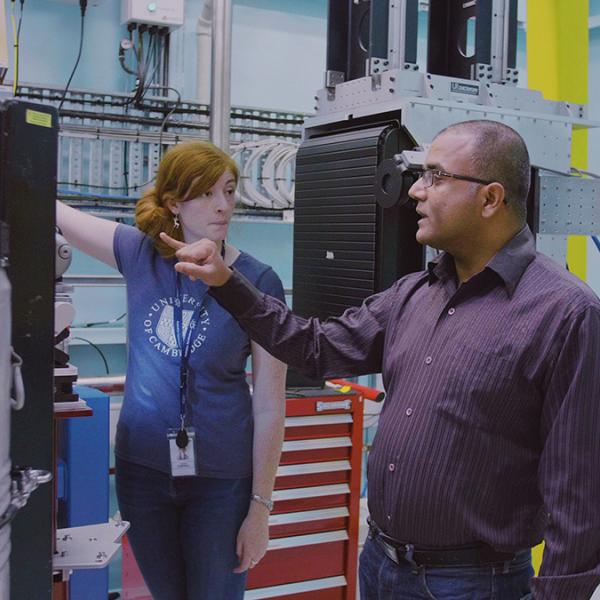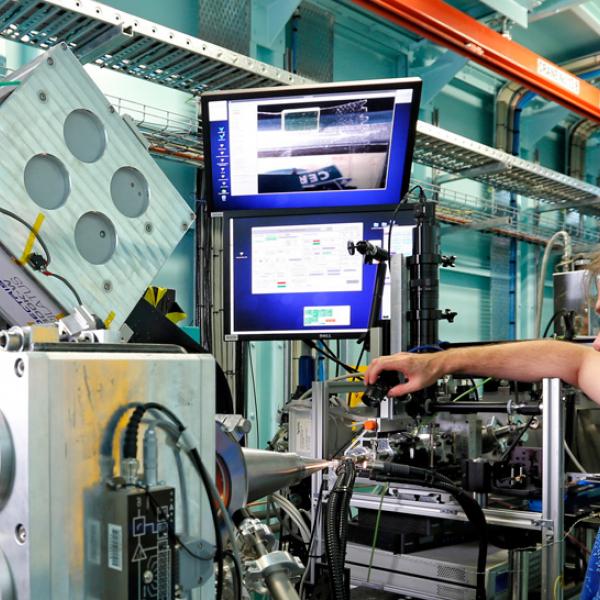

Published on the 1st December 2023 by ANSTO Staff
The 2023 Australian Synchrotron Stephen Wilkins Thesis Medal has been awarded to Dr Yanxiang Meng from the Walter & Eliza Hall Institute for Medical Research and the University of Melbourne for his research investigating the molecular mechanism at work in a form of programmed cell death, which is implicated in a variety of inflammatory diseases.
The award was announced on 28 November during the ANSTO User Meeting, which showcases the achievements of scientists who have used ANSTO facilities in their research.

Dr Meng made use of multiple synchrotron techniques, including macromolecular crystallography and small- and wide-angle X-ray scattering during his research that formed the basis of his PhD thesis: Mechanistic studies of RIPK3-mediated necroptosis in human cells.
In his career to date, Dr Meng co-authored ten peer-reviewed journal articles; 7 of which were directly associated with his PhD work and containing data from the Australian Synchrotron. These articles were published in high-profile journals such as Cell Death & Disease, Nature Communications, and Methods in Enzymology.
His university examiners remarked on the high quality of his thesis, with one examiner recommending the award with no corrections and the assessment “This is an outstanding effort that I would judge to be in the top 1% of PhD theses that I’ve encountered over 20 years. The candidate should be congratulated on providing such significant breakthroughs in science at such an early career stage.”
Dr Meng made extensive use of the MX1 and MX2 beamlines to determine a series of X-ray crystal structures of the MLKL protein in diverse conformations, complexes, and interactions. The validity of the structural models that Dr Meng proposed was then confirmed through scattering data collected using the SAXS/WAXS beamline and complemented by corroborative cellular evidence.
According to the judges, his findings have illuminated novel checkpoints within the cell death pathway and provided insights into the detailed activation mechanism and structural relationships between the proteins MLKL and RIPK3.
"After a short postdoc at WEHI, where I solved a further crystal structure using MX2 , I joined IonOpticks, a WEHI spinoff company, as an R&D scientist. Here, I am developing cutting-edge nanoflow chromatography technology for high-end proteomics applications," said Dr Meng.
The Stephen Wilkins Thesis Medal is awarded annually to the PhD student at an Australian or New Zealand University who is judged to have completed the most outstanding thesis of the past two years and whose work was undertaken at and acknowledges the Australian Synchrotron, or other international synchrotron research facilities and supported by access funding from ANSTO.
The prize was established in honour of Prof. Stephen Wilkins, who was a stalwart of X-ray and synchrotron research in Australia. Stephen was a CSIRO scientist for more than 35 years and made many pioneering contributions in the field of X-ray science.
He made key contributions in the field of X-ray crystallography and was the lead author of a seminal study on X-ray phase contrast imaging that was published in the journal Nature. This study has formed the basis of imaging and computed tomography capabilities at synchrotron facilities all around the world, including at the Australian Synchrotron’s Imaging and Medical Beamline and Microcomputed Tomography beamline.
In the early 1980s, as one of the first enthusiastic proponents of synchrotron radiation in Australia, Stephen Wilkins demonstrated how important this new tool would be to all the scientific disciplines. He was influential in the establishment of the Australian National Beamline Facility in Japan in the early 1990s, as well as in supporting the case for the establishment of the Australian Synchrotron in Melbourne in the early 2000s.
The Australian Synchrotron Early Research Award was presented to Dr Jiali (Maggie) Zhai of RMIT for her outstanding work solving outstanding biomedical problems by developing responsive and composite nanomaterials and innovations in value-added foods by advancing food colloidal systems.
Dr Zhai was recognised for her considerable expertise using synchrotron-based techniques such as small angle X-ray scattering (SAXS) and circular dichroism (CD) techniques, which she uses to develop new methods to study self-assembly in biologically relevant systems, and the structures of proteins and DNA at the membrane interface.



